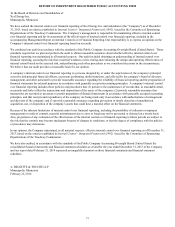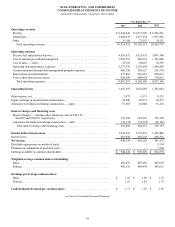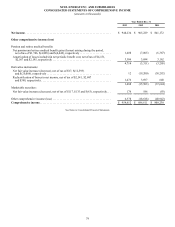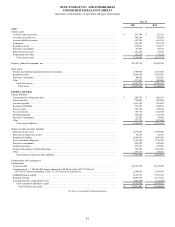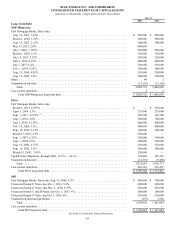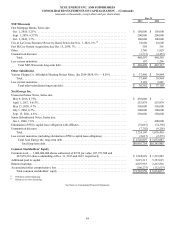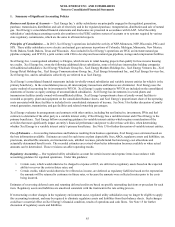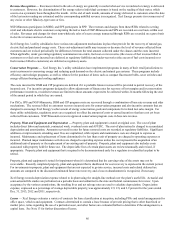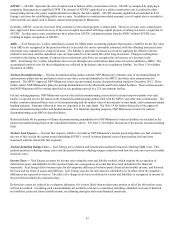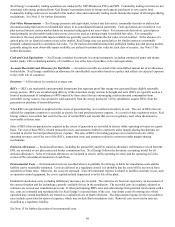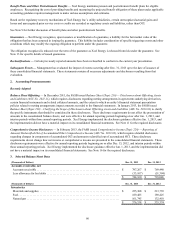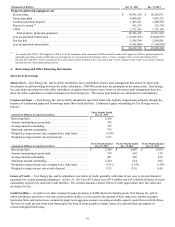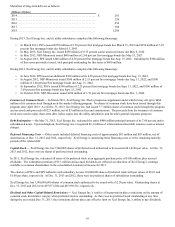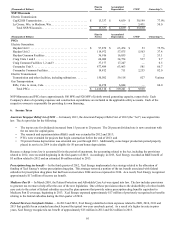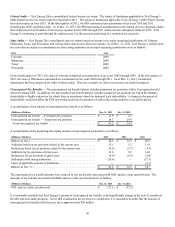Xcel Energy 2013 Annual Report Download - page 105
Download and view the complete annual report
Please find page 105 of the 2013 Xcel Energy annual report below. You can navigate through the pages in the report by either clicking on the pages listed below, or by using the keyword search tool below to find specific information within the annual report.87
AFUDC — AFUDC represents the cost of capital used to finance utility construction activity. AFUDC is computed by applying a
composite financing rate to qualified CWIP. The amount of AFUDC capitalized as a utility construction cost is credited to other
nonoperating income (for equity capital) and interest charges (for debt capital). AFUDC amounts capitalized are included in Xcel
Energy’s rate base for establishing utility service rates. In addition to construction-related amounts, cost of capital also is recorded to
reflect returns on capital used to finance conservation programs in Minnesota.
Generally, AFUDC costs are recovered from customers as the related property is depreciated. However, in some cases commissions
have approved a more current recovery of the cost of capital associated with large capital projects, resulting in a lower recognition of
AFUDC. In other cases, some commissions have allowed an AFUDC calculation greater than the FERC-defined AFUDC rate,
resulting in higher recognition of AFUDC.
AROs — Xcel Energy Inc.’s utility subsidiaries account for AROs under accounting guidance that requires a liability for the fair value
of an ARO to be recognized in the period in which it is incurred if it can be reasonably estimated, with the offsetting associated asset
retirement costs capitalized as a long-lived asset. The liability is generally increased over time by applying the effective interest
method of accretion, and the capitalized costs are depreciated over the useful life of the long-lived asset. Changes resulting from
revisions to the timing or amount of expected asset retirement cash flows are recognized as an increase or a decrease in the
ARO. Xcel Energy Inc.’s utility subsidiaries also recover through rates certain future plant removal costs in addition to AROs. The
accumulated removal costs for these obligations are reflected in the balance sheets as a regulatory liability. See Note 13 for further
discussion of AROs.
Nuclear Decommissioning — Nuclear decommissioning studies estimate NSP-Minnesota’s ultimate costs of decommissioning its
nuclear power plants and are performed at least every three years and submitted to the MPUC and other state commissions for
approval. The MPUC approved NSP-Minnesota’s most recent triennial nuclear decommissioning studies in December 2012. These
studies reflect NSP-Minnesota’s plans for prompt dismantlement of the Monticello and Prairie Island facilities. These studies assume
that NSP-Minnesota will be storing spent fuel on site pending removal to a U.S. government facility.
For rate making purposes, NSP-Minnesota recovers the total decommissioning costs related to its nuclear power plants over each
facility’s expected service life based on the triennial decommissioning studies filed with the MPUC and other state commissions. The
studies consider estimated future costs of decommissioning and the market value of investments in trust funds, and recommend annual
funding amounts. Amounts collected in rates are deposited in the trust funds. See Note 14 for further discussion of the approved
nuclear decommissioning studies and funded amounts. For financial reporting purposes, NSP-Minnesota accounts for nuclear
decommissioning as an ARO as described above.
Restricted funds for the payment of future decommissioning expenditures for NSP-Minnesota’s nuclear facilities are included in the
nuclear decommissioning fund on the consolidated balance sheets. See Note 11 for further discussion of the nuclear decommissioning
fund.
Nuclear Fuel Expense — Nuclear fuel expense, which is recorded as NSP-Minnesota’s nuclear generating plants use fuel, includes
the cost of fuel used in the current period (including AFUDC), as well as future disposal costs of spent nuclear fuel and costs
associated with the end-of-life fuel segments.
Nuclear Refueling Outage Costs — Xcel Energy uses a deferral and amortization method for nuclear refueling O&M costs. This
method amortizes refueling outage costs over the period between refueling outages consistent with how the costs are recovered ratably
in electric rates.
Income Taxes — Xcel Energy accounts for income taxes using the asset and liability method, which requires the recognition of
deferred tax assets and liabilities for the expected future tax consequences of events that have been included in the financial
statements. Xcel Energy defers income taxes for all temporary differences between pretax financial and taxable income, and between
the book and tax bases of assets and liabilities. Xcel Energy uses the tax rates that are scheduled to be in effect when the temporary
differences are expected to reverse. The effect of a change in tax rates on deferred tax assets and liabilities is recognized in income in
the period that includes the enactment date.
Deferred tax assets are reduced by a valuation allowance if it is more likely than not that some portion or all of the deferred tax asset
will not be realized. In making such a determination, all available evidence is considered, including scheduled reversals of deferred
tax liabilities, projected future taxable income, tax planning strategies and recent financial operations.


